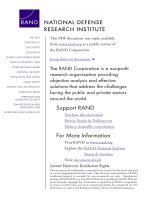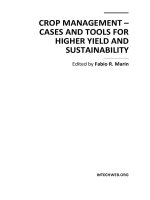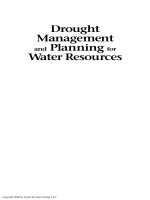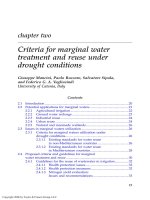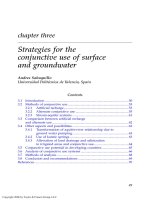2011 planning for tourism, leisure and sustainability
Bạn đang xem bản rút gọn của tài liệu. Xem và tải ngay bản đầy đủ của tài liệu tại đây (8.92 MB, 357 trang )
Planning for Tourism, Leisure and Sustainability
International Case Studies
This page intentionally left blank
Planning for Tourism, Leisure
and Sustainability
International Case Studies
Anthony S. Travis
International Tourism Consultant
CABI is a trading name of CAB International
CABI
Nosworthy Way
Wallingford
Oxfordshire OX10 8DE
UK
CABI
875 Massachusetts Avenue
7th Floor
Cambridge, MA 02139
USA
Tel: +44 (0)1491 832111
Fax: +44 (0)1491 833508
E-mail:
Website: www.cabi.org
Tel: +1 617 395 4056
Fax: +1 617 354 6875
E-mail:
© T. Travis 2011. All rights reserved. No part of this publication may be
reproduced in any form or by any means, electronically,
mechanically, by photocopying, recording or otherwise, without the prior
permission of the copyright owners.
A catalogue record for this book is available from the British Library,
London, UK.
Library of Congress Cataloging-in-Publication Data
Travis, Anthony S.
Planning for tourism, leisure and sustainability : international case
studies/Anthony
S. Travis.
p. cm.
Includes bibliographical references and index.
ISBN 978-1-84593-742-3 (alk. paper)
1. Sustainable tourism–Case studies. I. Title.
G156.5.S87T73 2011
910.68’4--dc22
2011011312
ISBN-13: 978 1 84593 742 3
Commissioning editor: Sarah Hulbert
Editorial assistants: Alexandra Lainsbury, Gwenan Spearing, Katherine Dalton
Production editor: Fiona Chippendale
Typeset by SPi, Pondicherry, India
Printed and bound by CPI Group (UK) Ltd, Croydon, CR0 4YY
Contents
Dedication and Aims
ix
Contributors
xi
Tourism Foreword
Jeff Hamblin
xiii
Heritage Foreword
Neil Cossons
xv
Introduction
PART I
INTERNATIONAL AND NATIONAL SCALES
OF TOURISM AND LEISURE PLANNING
xvii
1
World and National Systems of Heritage Resource Classification (RMP)
3
2 Planning for Tourism in a Post-industrial Society – a National Case Study
from the UK (RMP)
6
1
3
4
5
6
7
Planning for Economic Reconstruction and Change in a Post-war
Communist State: Case Study of Poland (RMP)
The Pilbara: a Sub-national Australian Study in 21st Century
Resource Development Planning
Jim and Wanda Kaucz
22
29
The Netherlands: a European Case Study of a Nation Planning
with an Over Abundance of Water
38
Israel: a Middle Eastern Case Study of Planning in a Mediterranean/Desert
Edge Location (RMP)
54
Denmark: a Scandinavian Case Study of Regional Conservation Planning
for Tourism and Recreation 1960–1980 (RMP)
64
v
vi
Contents
8
9
Maldives’ Tourism Development: a Test Case in the Indian Ocean
for Conservation and Economic Development
in an Islamic State (RMP towards STP)
70
Sustainable Transport to Tourist Destination Countries
75
PART II
REGIONAL TOURISM PLANNING AND NATURAL
RESOURCE PLANNING
81
10
Introduction to Mountain Region Planning for Conservation and Tourism
83
11
Introduction to the High Tatras and the Slovak High Tatras Case Study
88
12
The Polish Part of the High Tatras: the High Tatras and the Zakopane Areas
95
13
Subregional Resource Conservation Planning: the Firth of Clyde,
1970 – the First New European Strategy for Integrated Leisure
and Tourism Development
103
Upland Classical National Park Eco-model: the Plitvice Lakes National Park,
Croatia, 1990
112
14
15
16
17
18
116
118
Community-based Desert Ecotourism, Ancient Cities and Nomadic Cultures
Case Study 1: Petra, Wadi Rum and Aqaba, Jordan
Case Study 2: Tamanrasset and the Hoggar Mountains of the Sahara,
Southern Algeria
Case Study 3: Incense Trail of Nabbatean Cities in the Negev, Southern Israel
Case Study 4: Egyptian Ecotourism and Desert Tourism
119
120
120
Introduction to UK Upland Planning for Countryside Conservation,
Recreation and Tourism
Case Study 1: National Park Planning and Management
Case Study 2: The Upper Derwent Valley in the Peak District National Park
Case Study 3: The Tarka Project in Devon
122
123
125
127
Post-industrial Regional Tourism Planning: the South Wales
Valleys – Strategy for Development and Conservation in the 1980s
129
Nature and Culture: Developing a Rural Region’s Heritage Trails Through
Dolenjska and Bela Krajina in Slovenia
Marko Koscak and Anthony S. Travis
134
19
Host Cultures and Tourism: Is a Culture Sustainable?
141
20
Mid-Wales Festival of the Countryside: a Model of Events to Reinforce Rural
Culture and Life
Arwel Jones
150
Den Norske Turistforening – a Voluntary Sector Sustainable Programme
in Norway
Jan Vidar Haukeland
154
21
22
Cycling in the Netherlands – a Sustainable Move Forward
for a Whole Nation
Ton van Egmond
157
Contents
PART III
23
COASTAL AND MARITIME PLANNING AND MANAGEMENT
vii
159
Adriatic Coastal Development Planning by Federal Yugoslavia
(Now Croatia), 1960–1980
161
24
Planning the Coastline: England and Wales 1960–1970
165
25
Mediterranean Action Plan and Blue Plan
169
26
Tourism Carrying Capacity Assessment in the Mediterranean 1980–2009
Ivica Trumbic
175
27
‘Working with the Sea’: the 2008 Dutch National Response
to Global Warming and Sea Rise
PART IV
HISTORIC CITIES AND SUSTAINABLE TOURISM PLANNING
181
187
28
Historic Cities as Sustainable Tourist Destinations
189
29
Edinburgh: Post-war Urban Planning and Conservation
in a World Heritage City
193
30
Urban Event Tourism: Edinburgh – the Festivals and Many ‘Tourisms’
201
31
Salzburg: Management and Tourism in an Austro-Hungarian Festival City
206
32
Colonial Williamsburg: a Conserved and Renovated Settlement
as a Managed Cultural, Educational and Tourist Centre
212
33
The Sustainable Historic City Centre: Munich as a Model
219
34
Post-industrial Urban Centre Landscape Transformation:
Central Birmingham (UK) as a Test Case 1960–2010
223
Sustainable Transport in and at Tourist Destination Areas (TDAs)
229
35
PART V
36
LOCAL AND SITE SCALE OF TOURISM AND LEISURE SERVICES
PLANNING
231
Heritage Conservation Planning, at the Site Scale: Management
and Interpretation
233
37
Historic Sites: Case Studies of Three Battlefields
Case Study 1: Gettysburg, Virginia, USA
Case Study 2: Culloden, Scotland, UK
Case Study 3: Waterloo, Belgium
236
236
237
239
38
Tivoli: a Unique Danish ‘Pleasure Ground’ and Theme Park
241
39
US Heritage Parks and High-capacity Theme Parks in Virginia
245
40
The New Museumology – Site Interpretation and Animation
249
41
Regional Park Systems, Identity and Outdoor Recreation
in Metropolitan Areas
Case Study: The Huron–Clinton Metropolitan Authority (HCMA), Detroit
253
255
Beaulieu, UK: Recycling an Historic Private Estate
as a Major Tourist Attraction
262
42
viii
Contents
43
Integrated Community Building Complexes: Experimental Provisions
in the Netherlands and the UK
Case Study 1: The Pioneer Health Centre, Peckham, London (1935)
Case Study 2: The ‘Meerpaal’, Dronten in Flevoland (1967)
Case Study 3: ‘t Karregat in Eindhoven (1973)
Case Study 4: The ‘Agora’, Lelystad in Flevoland (1977)
PART VI ‘SLICING THE CAKE DIFFERENTLY’ – RESORTS, SPAS,
PILGRIMAGES AND CITY TOURISM
268
268
270
271
272
275
44
Introduction
277
45
Resorts are Not Forever
Case Study 1: The Scheveningen Story
Case Study 2: UK ‘Sea-Change Programme 2008’
Case Study 3: Bournemouth – a Sustainable Resort?
279
284
285
285
46
Long-life Pilgrimage Tourism and its Destinations
287
47
Cities as Sustainable Tourism Destinations
292
Appendix Sources and Acknowledgements
298
Bibliography
303
Index
319
Dedication
This book has to have a twin dedication.
First, to my wife Philippa and to my three children, Abby, Theo and Sandy, without whose
support and understanding nothing would ever have been achieved.
Secondly, to my rich global village of work friends, made in over 50 years of work and
travel in Poland, Slovakia, the Netherlands, Wales, New Zealand, Scotland, the USA, Canada,
Slovenia, Croatia, Serbia, England, Norway, Ireland, Hungary, China, Australia, Albania,
Austria, Estonia, the Maldives, Algeria, Israel, Jordan, Turkey, Italy, France, Switzerland,
Denmark, Sweden, Germany, Romania, Greece, Cyprus, Spain, Belgium and Bulgaria. The
shared learning has grown thanks to them.
Aims
In looking back over a span of 50 years’ worldwide experience as a tourism planner, my aims
in this book are not only to remind readers of how this new field has developed in its own
right, and of the creative planning responses to identified problems as opportunities, but also
to do it in a comparative way. I will do this by comparing:
·
·
·
the integrated planning response to water threat and needs for leisure and tourism in a
crowded capitalist country like the Netherlands, with economic- and tourist-development
responses in a water-short immigrant nation with a mixed economy like Israel;
the socialist planning for sport and social tourism of a post-war Poland, in dire economic
circumstances, with capitalist regional development in the 2000s in a huge, hot, dry, remote
region of North West Australia (which is twice the size of Poland!); and
tourism planning and development of an island archipelago state in the Indian Ocean that
is barely above sea level (the Maldives), with hi-tech planning for global warming and sea
rise in a below sea-level state such as the Netherlands.
Whether the issues have been maritime and coastal tourism that are compared, or the changing urban or resort condition, or looking at scales of planning (ranging from the national and
regional, down to the local and site scales of application), the book fully employs this comparative approach, for the benefit of the reader.
Tourism planning may be linked to or integrated in urban and regional planning, or tackled as a separate system of planning. On the national scale, tourism may be planned via
National Master Plans, Comprehensive Development Plans, as Facet Plans or Indicative Plans.
On the regional scale Tourism Strategies or Indicative Plans may be done, while below this
level subregional proposals may be for Tourist Destination Areas, or local plans, resort plans,
down to project and site development plans.
A primary purpose here is thus a comparative and evaluative one, approaching both current
and retrospective case studies, contrasting them so as to get important long-term lessons out of
specific and time-related situations. The book is targeted both at planners and at tourism planners, whether in training or in practice, as well as those who hold key interests in planning as
decision makers, advocates and stakeholders.
ix
This page intentionally left blank
Contributors
Dr Ton van Egmond, Senior Tourism Lecturer and Tourism Consultant, NHTV University of
Applied Sciences, Breda, The Netherlands. E-mail:
Jan Vidar Haukeland, Senior Research Sociologist in Tourism, Institute of Transport Economics,
Oslo, Norway. E-mail:
Arwel Jones, Regional Development Consultant. E-mail:
Jim Kaucz, Australian Regional Planner, Pilbara Region, Western Australia. E-mail: jim.kaucz@
planning.wa.gov.au
Wanda Kaucz, Australian Regional Planner, Pilbara Region, Western Australia. E-mail: wanda.
Dr Marko Koscak, Heritage Tourism Consultant, Slovenia. E-mail:
Emeritus Professor Anthony S. Travis, Urban and Regional Studies, The University of
Birmingham, and International Tourism Planning Consultant. E-mail: tony.travis@btinternet.
com
Ivica Trumbic, Project Manager, United Nations Environment Programme (UNEP)/
Mediterranean Action Plan (MAP), Global Environent Facility (GEF) Strategic Partnership
for the Mediterranean Large Marine Ecosystem (Med Partnership). E-mail: Ivica.trumbic@
unepmap.gr
xi
This page intentionally left blank
Tourism Foreword
For too long, particularly in the 1950s, 1960s and early 1970s, tourism was seen by many
countries as a cash cow, and apparently little more than that. Examples abounded of unplanned
or barely planned resorts, their sole objective seeming to be to separate visitors from the contents
of their wallets, with little or no thought given to the environment.
Concrete monstrosities built on many parts of the Mediterranean coast, for example, perhaps offered people from colder, northern climes the opportunity to bask in sunshine at an
affordable price. However, the newly constructed resort towns had little of the character of the
host country and, as a result, did equally little to help that country in the long term.
It wasn’t all bad; there were examples of sensitive and well thought-out development.
None the less, by the early 1970s, there was considerable mistrust about the negative influences tourism would bring to places bold enough to consider its potential for economic gain.
There couldn’t have been a better time for the emergence of a number of notable thinkers
and planners, of which Tony Travis was one of the most prominent, and the most gifted. He
held the view that tourism could be a force for economic and environmental good at the same
time. He was a leader in the belief that, if tourism could be absorbed by the host environment,
rather than dominate it, there could be a bright and sustainable future for it.
His research, guidance and teaching, helped to nurture a number of people from a wide
range of backgrounds, who became first generation experts in the field. Slowly at first, but
with gathering pace, the development of sustainable tourism and the effective marketing of
the industry reached new and impressive levels of sophistication. People began to think of
heritage, conservation and tourism in the same breath, as it became clear that, with careful
planning, they could and should be interdependent for the combined greater good of the environment and the economy.
I was fortunate enough to have the opportunity to join the industry in the early 1970s and
to benefit from the guidance of Tony Travis. My grounding in the principles of planned growth,
which would generate economic well-being without destroying the very fabric of what the
visitor came to see, formed the bedrock upon which my career and the careers of many of my
colleagues was built.
This book offers a plethora of examples of how countries, regions and local areas have
tackled the tourism and environmental challenges they have faced. There are excellent case
studies, many learning points and numerous issues are investigated and commented upon.
Thanks in no small part to works of this depth, I feel that the future of the tourism industry
can be a very bright one. I firmly believe that it can be a force for economic good, it can help to
xiii
xiv
Tourism Foreword
arrest rural depopulation, it can help to foster international understanding and it can bring
people together.
The challenges in the future will be many. But if we can learn from our failures, as well as
from our successes, the needs of the environment can be addressed and, at the same time, the
economic well-being of that environment can be enhanced. An analysis of the case studies,
contained within the chapters that follow, can only help towards achieving those goals.
Jeff Hamblin
Former Chief Executive
The British Tourist Authority
Heritage Foreword
Tourism corrupts. Absolute tourism corrupts absolutely. But it doesn’t have to be like that. In
this book Tony Travis brings a lifetime’s experience to bear in demonstrating, through an
eclectic mix of case studies, that tourism can be a creative and responsible force for good and
the key to the revival, survival and continuing prosperity of communities all over the world.
Further, his observations on national planning studies demonstrate the essential nature of the
relationship between the conservation of landscapes, exemplified in a wide variety of environments, from deserts to coastlines, and the uses to which they are put. His illustrations
show that there are no easy answers but what they do to great effect is to offer exemplars of
approaches that can shape and inform the way in which people interact with places and how
tourism can be sustained as a component of that relationship.
Since 1887, when Lord Acton famously declared that power tends to corrupt, he has been
proved right in a tragic number of cases. Look around the world today and there are tyrants
still roaming wild whose crimes, because they don’t matter enough to enough people, are
allowed to continue unfettered. The tyrannical power of tourism in its unmanaged state is not
dissimilar but at least there are grounds for optimism. There are unlimited examples of good
practice; the challenge is to use them to influence the rest.
Give mankind the opportunity to move about the world and he will take it. Give him the
net disposable income and he will chose to spend a surprisingly – and increasingly – high
proportion of it in someone else’s back garden, whether invited or not. For Lord Acton and
his generation it was the few who could afford such luxuries. But even then it was a rapidly
expanding few, made prosperous by the fruits of industrialisation and given the means to
travel by the spread of the railway. There was another factor too, as pertinent then as it is
now; that the newly prosperous lived increasingly in towns and cities and their delight was
to spill out for a few days or weeks each year and spend some time in a different place. For
some that meant a resort, designed and built for their pleasure, where there were plenty of
people like themselves; fellow workers from the cotton mill all on the beach together in
Blackpool, the world’s first working-class resort. In one sense these resorts represent the
most benign form of tourism, not least because the resource is designed from scratch for
people and their enjoyment.
But for others, the aspirational cognoscenti, their pleasure was in visiting places that
nobody else had yet found. Their effects can be more insidious, at worst like a plague of
locusts sweeping through innocent landscapes and communities, moving on when – as inevitably happens – others follow them and the taste of discovery and revelation starts to pall.
xv
xvi
Heritage Foreword
For the host communities affected by these tidal movements there is no turning back, visitors
and their spending become a crucial part of the local economy and the only way to sustain a
way forward is to encourage more of them. Meanwhile, the adventurous have fled in search
of new delights untainted by people like themselves.
To this catalogue of apparent gloom we can now add the tricky concept of sustainability.
In the age of ever-cheaper air travel more people can travel to more places than ever before.
And more of them will go as far as they physically can before they pause. No longer is money
a restricting factor and, in the absence of a flat earth, there is no edge for them to fall off when
they get there. And, paradoxically, as awareness of climate change and carbon issues grows,
so too does our ability to say to ourselves, this is not something that directly affects me. My
flight to a beach 5000 miles away is acceptable because it is me. Tourists, after all, are always
other people.
So, today, everywhere is accessible to everyone. For the first time in human history there
is nowhere left on earth to hide. And it is that factor – and perhaps that factor alone – that gives
us both pause for thought and the means of taking stock. Just as we can start to see the limits
of the world’s resources so too we can see the boundaries of our capacity and need to travel for
the sake of it.
This book is about taking stock, about understanding the limits, creatively shaping the
opportunities, moulding the relationship between people and the places that, by visiting, they
increasingly see as their own. It is not a textbook of what to do and not to do, more a series of
pertinent and perceptive object lessons drawn from Tony Travis’s exceptional and unique
experience of planning and responsible tourism over some 40 years. The historical perspective
is crucial, for here we can see and begin to understand the roots of current thinking and
practice.
Tony Travis was one of the first in this field, pioneering through his research and teaching
the concept that only through an integrated approach, bringing conservation, planning and
management together as parts of a single debate are we likely to see truly sustainable outcomes. Some of the studies in this book are from 30 and more years ago. Seen through the lens
of our current concerns they are perhaps more relevant today than when they were written.
This book is a gold mine of such examples, and you don’t even have to visit a gold mine to taste
the benefits.
Sir Neil Cossons
Past Chairman
English Heritage
Introduction
Man’s primary urge in development for the
last 2000 years at least, has been to exploit the
natural and human resources of the planet,
for his material benefit and advancement.
Mid-20th-century Man’s resource management failures led to the move from remedial
towards sustainable management ideas in
that period. The roots of sustainable development and of sustainable tourism development long pre-date the Brundtland Commission
Report (1987), which was a critical kick-starting
phase of political action on the world scale,
in planning for sustainability, but one can
point to roots in some five earlier streams in
human history:
1. The ecological wisdom of indigenous peoples living within the tight parameters of
harsh ecosystems, achieving long-term survival, and that of their host habitat. Thus the
Aborigines of Australia, living within the tight
constraints of its desert ecosystem, or the
Bushmen of the African Kalahari Desert, and
the indigenous tribes of the tropical rainforests of South American Amazonia, all exemplified sustainable management philosophies
and practices.
2. The nature conservation movements,
rooted in romantic literature and art, with the
writings of Henry David Thoreau and John
Muir, and leading to the mid-19th-century
creation of Yosemite National Park, and the
start of a worldwide movement in creating
National Parks, and later nature reserves and
other categories of protected habitats and
ecosystems.
3. Man’s learning to deal with critical natural resource problems – such as too much or
too little water – in his host environment. For
example, the long history of the Dutch people
in claiming a land from the marshes, riversides and sea. They started ‘impoldering’ as
early as the 14th century! The Nabbatean
civilization in the Middle East about 2000
years ago created an urban society in a desert
environment, based on skilful water extraction, conservation and survival in a harsh
habitat. Nearly 2000 years later, Israelis, in
the same desert, have to try out archaeological restoration work to relearn such desert
survival skills.
4. Man’s suffering from failure to intelligently manage rich, natural-resource habitats,
for example the ploughing up of US prairie
grasslands for mono-agriculture, and creating
the ‘Dust Bowl’ in the interwar 20th century.
It took ruin, rural migration and major economic recession collapse to get the resultant
‘New Deal’ and the creation of a Tennessee
Valley Authority (TVA) to control the waters
of a huge river basin, create dams, water management, and develop responsible agriculture
and farming using new hydro-electric power
to regenerate an economy. This and other
xvii
xviii
Introduction
water-economy lessons in the USA pre-dated
the national water-economy plans for nations
like Poland and Israel.
5. Land-planning lessons from late 19thcentury and early 20th-century thinkers and
practitioners, laid foundations for town and
country planning systems and statutory planning in many European countries after the
end of the Second World War, in the 1940s.
Land-use planning later took on other management tasks such as air quality management, environmental impact assessment and
other elements of the later sustainable environmental management.
Resource Conservation
Modern ecology literature first introduced
ideas of sustainability, while the public face of
environmental sustainability, in world terms,
had to await the Brundtland Report in 1987.
This was well after the push for responsible
global environmental management which
surfaced in the 1960s and 1970s, with work
such as that of the Club of Rome and E.F.
Schumacher’s Small is Beautiful in 1973, where
he writes:
This . . . is . . . due to our inability to recognize
that the modern industrial system, with all its
intellectual sophistication, consumes the very
basis on which it has been erected. To use the
language of the economist, it lives on
irreplaceable capital which it . . . treats as
income . . . three categories of such capital:
fossil fuels, the tolerance margins of nature,
and the human substance.
From 1987 to 2002 a sequence of over 20
world conferences after Brundtland, has
taken Man from sustainability to sustainable
development and on to sustainable tourism
planning. Now, in the early 21st century, the
perceived global management problems
have accelerated both in urgency and in
scale, as scientific evidence points to Man’s
causal role in ‘global warming’ due to his
excess production of carbon dioxide, his
damage to global oxygen production (by
destruction of tropical rainforests), all associated with the dangerous ‘hole in the ozone
layer’. National governments, such as that of
the Netherlands, are forced to do reports
such as the 2008 Delta Commission Report
on raising sea and river defences to cope
with expected sea rise, and the UK Government to commission the Stern Report on the
environment. Sustainability of life and habitat has become a practical concern. The role
of tourism, both as one of Man’s fundamental freedoms and as giving rise to the world’s
largest industry, has key new roles to play.
Short-term horizons are inadequate to protect the vital interests of successive generations of life in future, on this exceptional
planet.
Effective resource conservation of our
built and cultural heritage is an even younger
notion than that of natural resource and landscape conservation and management. The
19th-century concept of National Parks predates the protection and listing of historic
buildings and monuments, let alone cultures,
which has generally been more of a 20thcentury idea. Yet, in relation to tourism, it is
the mix of the diversity of climates, heat and
snows, diversity of habitats, of landscapes, of
architecture, of cultures, languages, monuments and cuisines that give rise to much of
tourism and leisure travel. Modern Man is as
guilty as his predecessors not only of deforestation, environmental damage and pollution, but is still guilty of destroying the
habitat of native peoples in the tropical rainforests (see Hanbury-Tenison, 1984). Though
we deplore the past fate of the North American
Indian, the Australian Aboriginal and the New
Zealand Maori at the hands of ‘white settlers’,
the land-grab and forest resource destruction
today in places like Amazonia continues this
vile process.
Responsible Development
versus Exploitation
The notion of ‘development’, so vital to modern,
industrial and urban society, is synonymous
with large-scale exploitation of key natural
resources such as land, minerals and water.
Large-scale agricultural and pastoral outputs
are vital to feed the growing huge urban
populations. Conservation is a concomitant of
Introduction
development, but the political and economic
power of conservation agencies is marginal.
Internationally, the International Union for
Conservation of Nature (IUCN) and the World
Wide Fund for Nature (WWF) are the prime
advocates for environmental and natural
resource management, biodiversity and species protection. At the global level the United
Nations Educational, Scientific and Cultural
Organization (UNESCO) is the primary agency
for identification, listing and protection of the
world’s built and cultural heritage, and to a
lesser extent, the world’s natural monuments.
In effect they have largely to rely on effective
actions by national governments and agencies. UNESCO cannot enforce protection.
When in 2008 the nations of the world had
such difficulty in dealing politically and economically with the so-called ‘credit crunch’
that made world capitalism creak, one fears
for the global will and ability to deal effectively with alternative energy production,
and resource conservation and management
issues.
Linking Conservation
and Development
Developed nations today are selfcongratulatory if they achieve 5% or 10% of
their territory being allocated for National
Parks and National Nature Reserves. These
are the areas of strict resource, habitat and
landscape protection. Yet today much scientific evidence points to the need for greatly
increased national forest cover, at a time when
deforestation is at an unprecedented scale in
world terms. Wetlands need extension, but
we destroy them – estuaries, with their rich
biotic production, are locations for intensive
economic development. Sustainable energy
sources which are carbon neutral are needed,
as are actions which will reduce deserts and
not aid desertification. Further, wise management of alpine zones under pressure, and of
polar zones, are key issues which are only partially addressed. While the post-’87 rush of
conferences and writing about sustainability
is notable, we must be careful about sustainable tourism and apply critical evaluation. This
xix
book is part of the move towards sustainable
tourism, but it is early days, and while many
examples to date are good in terms of direction, all are only partial in terms of achievement of sustainability, for the sorts of reasons
which I have already given in this sobering
introduction. Worldwide examples are taken
in this book, from initiatives in the last 50 years
that have demonstrated partial answers to
providing sustainability; none have achieved
totally sustainable tourism, but move part of
the way towards sustainability. The author very
much agrees with van Egmond’s statement on
p. 188 of The Tourism Phenomenon (2008), where
he writes:
U.N.E.P.’s Agenda for Sustainable Tourism
clearly demonstrates that focusing on both
economy, social and cultural aspects, and
environmental issues, as well as visitor
fulfilment, is extremely complex. Tourism
that is sustainable in every respect will be
difficult to achieve. That is why we refer to
sustainable tourism development – trying to
achieve sustainability – rather than sustainable
tourism.
Some sustainable tourism products, such as
cycling in the Netherlands, rail-based international holidays and ‘deep ecology’ ski or footbased holidays in Norway, are among the
positive elements already found.
Determinants
To put this into context, one needs to take
an historical perspective, and co-relate four
streams of change (Fig. I.1), which writers
such as Sigaux (1966) and Towner (1984) have
emphasized:
•
•
•
•
wealth, power and access to travel;
technologies of travel;
development of a tourist industry; and
from laissez faire to planning, and the
limits of change.
Alternatively, one can co-relate critical
changes in scale, over time, of population
growth, human mobility, and related energy
and resource consumption (see Fig. I.2). For
the interdependence of tourism, and heritage
resources see Fig. I.3.
xx
Introduction
Four streams of change
Wealth, power and
access to travel
1660: The ‘Grand
Tour’ of Classical
Europe
1840: Start of the
railway age
Technologies of
travel
Horse, carriage,
road, sail, start of
steam
Rail, coal, steam,
steel transport
technologies
European, American
and African rail
Tourist industry
development
Travel for courts and
the rich
Laissez-faire
provisions
1851: Test case for
Great Exhibition;
Thomas Cook;
domestic tourism;
world packages
Laissez-faire
developme nt of
cities, ports and
systems, risks and
failure, paternalistic
philanthropy , public
health action
Start of planning in
Europe and North
America
Industrial pollution,
health hazard
Suburbia
1880: Mass sea
travel
Steamship liners
Commercial rail and
sea offers
1914–1918
Dirigibles and military
aircraft
Commercial air travel
and sea-cruising
Airwar
Peace
Sea travel, car
War
1920
1939
1945
1950
Laissez-faire,
planning impacts
and limits of
change
Middle-class
international holidays
War
Reconstruction
Holiday camps
Post-warplanning,
Clean Air Act 1956
1960: Mass air travel
Jumbo jet, charters
Universal travel for
1960s’ Club of Rome;
North West Europeans Roots of sustainable
tourism
1990
Economy airlines
Start of sustainable
tourism
2000: Global warming, energy crisis,terrorism, natural disasters
2005: Nowhere is remote, carbon-neutral initiative, responses to global warming
Fig. I.1. An historical perspective: four streams of change.
The Impacts of Economic Globalization
on Tourism
In the 19th and 20th centuries the developed
world was associated with urbanization,
industrialization and rural de-population,
but by the beginning of the 21st century, not
only the developed world but much of the
so-called ‘Third World’ or ‘developing world’
is associated with the growth of vast urban
agglomerations or so-called ‘megalopolises’
with 10, 20 or more million inhabitants in each
of them. By 2000 there were already 20 cities
each with a population of over 10 million. In
order to function, these world cities, which
are found on all continents, demand and generate world flows of raw materials, energy,
foods and goods. Such urban magnets are
found as much in China, India and the
Americas, as in Europe. The flows of materials, goods and ideas generated by them,
is equalled by the change in scale of world
tourism flows, but the populations of these
world cities have unequal access to these
travel opportunities.
Exploding Numbers of Tourist
Destinations
The tourism or travel explosion of the last 50
years – from 1955 to 2005 and beyond – has
seen shifts in the location of new tourist
destinations, as fashions, surplus disposable
income, types of tourism and mass access to
Introduction
WORLD POPULATION
GROWTH
Roman
ENERGY and RESOURCE
CONSUMPTION BY MAN
HUMAN
MOBILITY
×
Mediterranean
World
xxi
Wheel, on horse,
on foot, sail
TIME
Sail
Charcoal
1500: World
travel starts
Medieval
Coal
1 billion
Water
2 billion
Steam
Coal and iron
Modern
Gas
Petrol
Electricity
1960: Air travel
general
3 billion
6 billion
Nuclear
Clean energy sources:
solar, wind and wave
2008
Fig. I.2. The critical relationship of population growth to energy and resource consumption.
TOURISM
Tourism’s dependence on three sets of heritage resources
en
Cu
Cu
La
Id
ng
tit
y
of
Climate
ltu
re
s
ua
ge
s
ltu
pl
ac
re ral
es
h
so e
ur rit
ce ag
s e
Nature
Habitat
Wildlife
Landscapes
re
ctu y
log
c
eo ring
Ar
a
ch ee nts
Ar gin me
ge
En onu
ita s
r
M
he ce
ilt ur
Bu reso
e
hit
Natural heritage
resources
Fig. I.3. Tourism’s dependence upon three sets of heritage resources.
cheap international travel, has changed the
map of tourist destinations. Taking the example of European-generated tourism movements, the shifts in destination development
have been from traditional North European
resorts on the coasts of the UK, the Baltic,
North Sea and resorts of the French and Italian
Rivieras, first to Spanish (and Portuguese)
xxii
Introduction
Costas, then to Majorca and west Mediterranean
islands, then on to the Adriatic development of
the Yugoslav coast, and to Greece, Turkey and
Cyprus. The desire for guaranteed winter sun
led on to development of the Canaries and
Madeira to satisfy North West Europeans, to
Florida and the Caribbean, supplementing
North American movements there, and to
the sun belt of the Red Sea – to Egyptian Sinai
resorts and to Gulf of Aqaba resorts in Israel
and Jordan. European initiatives have also led
to the exploitation of ‘dream-islands’ in the
Indian and Pacific Oceans, so that places like
the Maldives and Seychelles, Mauritius and
Fiji have developed, while exotic cultures and
low prices drew them on to places like Bali,
Goa and to Thailand.
The expansion of cruising in the last decade has extended visits to the Baltic, Norway’s
fiords, the Caribbean, the Mediterranean,
to the edge of Alaska, and sea-based visits
to the Polar regions. The growth of outward
Japanese and Korean world tourism, and of
North Americans touring their own continent, have been significant, but we have yet
to see the impact of massive change when
large-scale outward Indian- and Chinesegenerated tourism ‘hits’ the globe. The design
of resorts in the last 50 years has been largely
placeless; the new tourism lacks cultural
understanding and respect for host cultures –
as can now be evidenced in resultant law cases
in places such as Dubai and the Maldives.
Only pilgrimage tourism shows respect: when
the visitors, for example Islamic tourists on
the Hajj visit a traditional Islamic society –
Saudi Arabia. Then cultural norms of hosts and
guests are shared.
Figure I.4 outlines the tourist system.
What is sustainable tourism? Sustainable
tourism is redefined by Travis (the author) as:
Man’s responsible long-term use and re-use,
for tourism purposes, of human resources,
and of three sets of heritage resources –
natural, cultural and built –to meet effective
consumer demand within the limits of the
capacities of those resources, for the benefit
of both the tourists and of the permanent
resident communities at the tourist
destinations.
And what is sustainable tourism planning?
Sustainable tourism planning is redefined by
the author as:
Defining and developing practical action
programmes comprising a bundle of
Environments: physical, technological,
social, cultural, economic, political
TOURIST
GENERATING
REGIONS
Departing tourists
• Ticketing services
• Tour operators
• Travel agents
• Marketing and promotion
Channels of transport and communication
Fig. I.4. The tourist system.
Shared host
leisure
services
Returning tourists
TOURIST
DESTINATION
REGIONS
• Accommodation sector,
the catering and drinks
industry
• Entertainment industry
• Tourist attractions and events
• Shopping
• Tourist services
Location of the Tourist Industry
Introduction
xxiii
WORK-RELATED
Business tourism
Meeting tourism
Conference tourism
Exhibition and trade fair tourism
LEARNING-RELATED
Educational tourism
Language and skill acquisition
Holidays
Gap year tourism
Cultural tourism
Literary festival
HEALTH-RELATED
Spa treatment tourism
‘Wellness’ tourism
Hospital treatment abroad: medical
tourism
PLAY and LEISURE-RELATED
Pop festival tourism
Gap year tourism
City break tourism
Sports tourism: winter sports,
water sports, air sports
Ecotourism and nature tourism
Nature trek holidays
Birdwatching holidays
Walking and cycling holidays
Climbing holidays
Cruising holidays
Beach resort holidays
Cultural tourism
Festival and event tourism
Hen and stag parties abroad
SPIRITUAL and BELIEF-RELATED
Pilgrimage tourism
Beachcomber tourism
Backpacking tourism
Treks to meet gurus
Fig. I.5. An indicative spectrum of types of tourism.
development and conservation policies, and
achieving their realization through fiscal and
agency means, to deliver sustainable tourism
products.
There are many ‘tourisms’, and an indicative
range is given in Fig. I.5. These are crude indicative ‘tourisms’. However, much past so-called
theory of tourism was drawn from leisure theory literature, shaped by writers such as Veblen,
Maslow, Kelly and Dumazedier. Latterly, within
the tourism field itself, the contributions of
writers such as Plog, Schmoll, Iso Ahola, Erik
Cohen, Weber, Krippendorf and McCannell
are notable. Recently newer writers such as
Wang, van Egmond and Jenkins are deepening
our understanding of the tourist himself.
Four types of model are explored in case
studies in this book:
•
•
•
Model A: multiple stakeholder model,
with maximum destination community
benefit (MSM-CB). This includes the
North Pennines Growth Point, Mid-Wales
Festival of the Environment, the Slovene
Heritage Trail, and others.
Model B: tourism carrying capacity
assessment models (TCCA). This includes a range of case studies given in
Part III.
Model C: sustainable tourism planning
models (STP) examples. These extend from
early experimental models of the 1970s
xxiv
Introduction
A protected area is an area of land and/or sea especially dedicated to the protection and maintenance of
biological diversity, and of natural and associated cultural resources, and managed through legal or other
effective means.
Although all protected areas meet the general purposes contained in this definition, in practice the
precise purposes for which protected areas are managed differ greatly.
Protected Area Management Categories
IUCN has defined a series of six protected area management categories, based on primary management
objective. In summary, these are:
CATEGORY Ia:
Strict Nature Reserve: protected area managed mainly for science
Definition
Area of land and/or sea possessing some outstanding or representative ecosystems, geological
or physiological features and/or species, available primarily for scientific research and/or environmental monitoring.
CATEGORY Ib
Wilderness Area: protected area managed mainly for wilderness protection
Definition
Large area of unmodified or slightly modified land, and/or sea, retaining its natural character and
influence, without permanent or significant habitation, which is protected and managed so as to
preserve its natural condition.
CATEGORY II
National Park: protected area managed mainly for ecosystem protection and recreation
Definition
Natural area of land and/or sea, designated to: (a) protect the ecological integrity of one or more
ecosystems for present and future generations; (b) exclude exploitation or occupation inimical to
the purposes of designation of the area; and (c) provide a foundation for spiritual, scientific,
educational, recreational and visitor opportunities, all of which must be environmentally and
culturally compatible.
CATEGORY III
Natural Monument: protected area managed mainly for conservation of specific natural features
Definition
Area containing one, or more, specific natural or natural/cultural feature which is of outstanding or
unique value because of its inherent rarity, representative or aesthetic qualities or cultural
significance.
CATEGORY IV
Habitat/Species Management Area: protected area managed mainly for conservation through
management intervention
Definition
Area of land and/or sea subject to active intervention for management purposes so as to ensure
the maintenance of habitats and/or to meet the requirements of specific species.
CATEGORY V
Protected Landscape/Seascape: protected area managed mainly for landscape/seascape conservation and recreation
Definition
Area of land, with coast and sea as appropriate, where the interaction of people and nature over
time has produced an area of distinct character with significant aesthetic, ecological and/or cultural
value, and often with high biological diversity. Safeguarding the integrity of this traditional interaction is vital to the protection, maintenance and evolution of such an area.
CATEGORY VI
Managed Resource Protected Area: protected area managed mainly for the sustainable use of
natural ecosystems
Definition
Area containing predominantly unmodified natural systems, managed to ensure long-term
protection and maintenance of biological diversity, while providing at the same time a sustainable
flow of natural products and services to meet community needs.
Fig. I.6. The IUCN definitions of protected areas (Source: IUCN, 1978).
